Tomato Products Package
Canned Tomatoes

There are numerous debates regarding tomatoes, involving discussions on whether they are fruits or vegetables. Indeed, tomatoes are botanically classified as berries, but they are commonly considered vegetables. Tomatoes can be canned easily and successfully, and later used as side dishes. The information presented on the package reflects that canned tomatoes are of Canadian choice. This means that people prefer eating natural vegetables preserved in cans and mainly used when fresh tomatoes are unavailable. “Canada choice” information provided on the label correlates with the current food consumption trends in the country, where the popularity of natural foods and veganism is increasing.
Tomato Juice
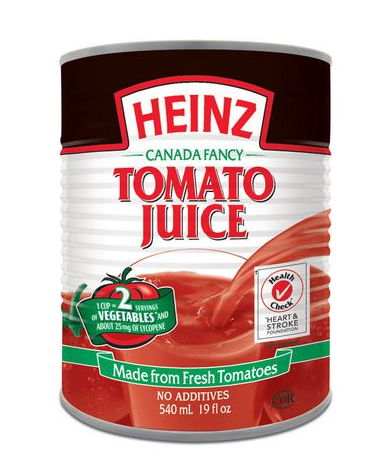
Tomato juice is obtained by squeezing tomatoes and adding salt for preservation purposes. Even though the popularity of vegetable juices is gradually decreasing in Canada, the information on the Heinz tomato juice package depicts that it is made of fresh tomatoes with no additives, contains 25 mg of lycopene and two full servings of vegetables in every 250 ml, and shows a connection with the Heart and Stroke Foundation. This information reflects such trends as the packaging connection, the cleaner label, and the intersection of health and convenience.
Tomato Ketchup
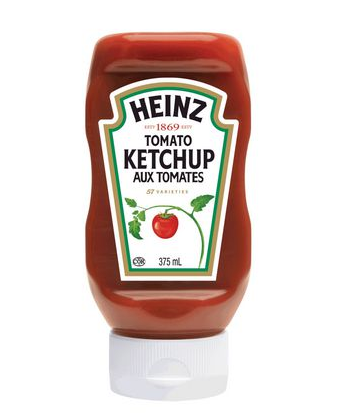
Ketchup is also made of tomatoes but with added vinegar, sugar, and spices. This particular Heinz Ketchup package is very laconic, and only depicts some information about the company, and does not reflect any food consumption trends.
Sundried Tomatoes
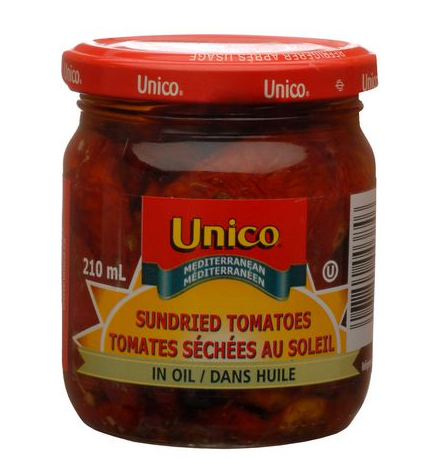
Sundried tomatoes preserved in oil are not as popular as canned tomatoes or ketchup. This Unico package only states that tomatoes are from the Mediterranean, which reflects on such food consumption trends as gourmet convenience and cleaner labels.
Ingredients
Canned tomatoes
Ingredients: tomatoes, tomato juice, salt, calcium chloride, citric acid.
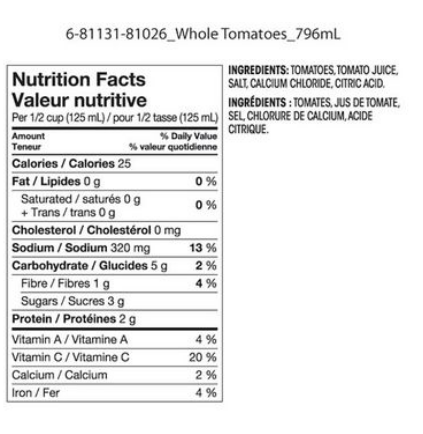
Tomato juice
Ingredients: tomato juice, salt.
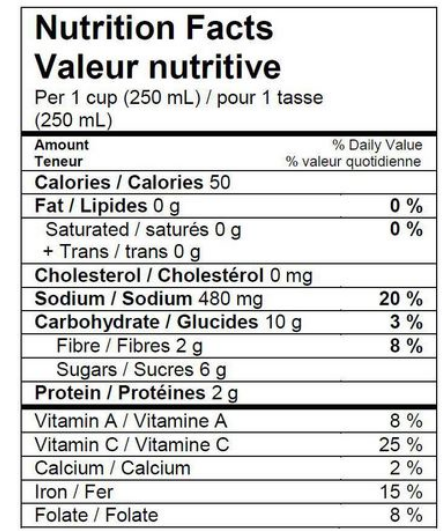
Tomato ketchup
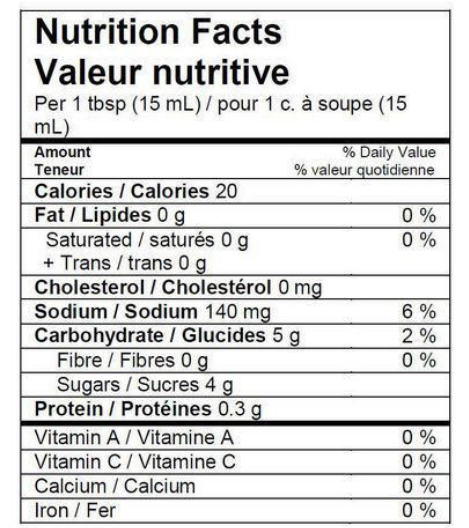
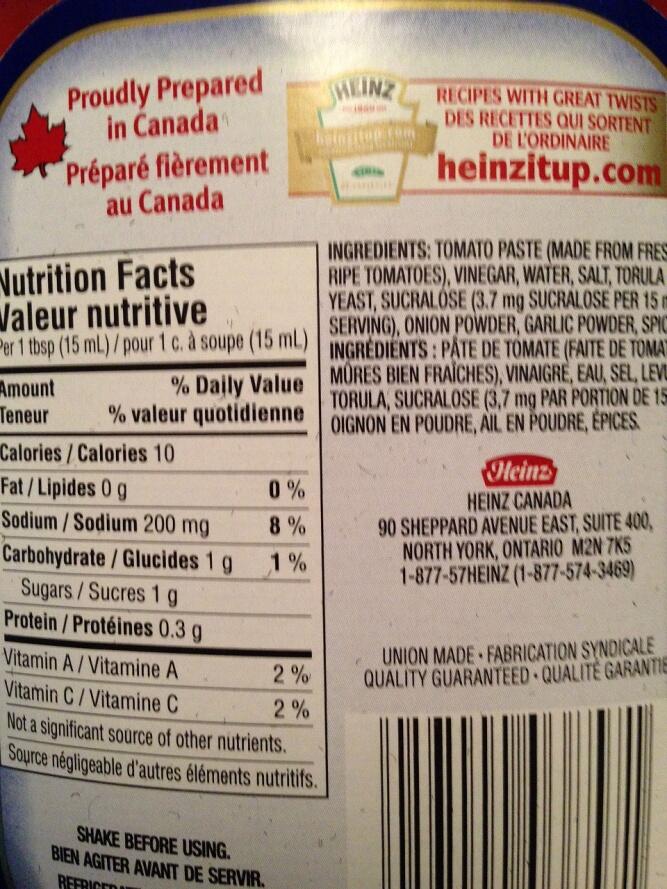
Sundried tomatoes
Ingredients: sundried tomatoes, sunflower oil, extra virgin olive oil, herbs (oregano, mint) Citric Acid, Sodium metabisulphite.
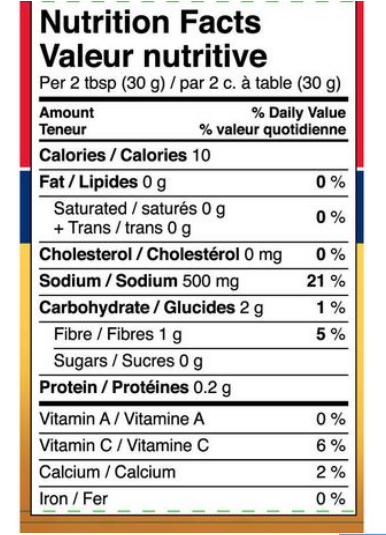
Macro/Micro Food Components
For canned tomatoes, a citric acid ingredient is chosen for further analysis. It is a micro food component that belongs to the group of organic acids. Citric acid impacts flavor and tartness and is used as an antimicrobial agent in this case.
Obviously, the tomato juice ingredient was chosen in the Heinz tomato juice product. In this case, it is a source of water, the macro food component. The water’s main function in tomato juice is to absorb macromolecules, such as proteins and polysaccharides. Tomato juice is also a source of Vitamin A and Vitamin C that is considered a natural preservative.
For ketchup, garlic powder as the micro food component is chosen. Garlic powder is used in this product for flavoring to nurture it with the taste and aroma.
For sundried tomatoes, extra virgin oil is selected as a macro food component, fat, in particular. Extra virgin oil’s primary functions in this product constitute the reduction of oxidative rancidity, assuring proper storage of dried tomatoes, and hydrogenation.
Food Additives
Calcium chloride is chosen among the additives listed on the canned tomatoes’ package. Calcium chloride is salt that is solid at room temperatures, so its main function is preservative in this case. According to Health Canada (2018, “List of Permitted Food Additives”), it falls into the list of permitted food additives with other accepted uses.
Salt is the only additive present in Heinz tomato juice. Similar to calcium chloride, the main function of salt is to preserve tomato juice for long periods. Under the Food and Drug Regulations of Canada, salt is not included in the food additives list.
Vinegar, or acetic acid, is selected as an additive included in Heinz ketchup. Its key functions are flavoring and preservation of ketchup for a considerable amount of time. Owing to vinegar, ketchup can be kept in the fridge for about eight weeks once opened. According to Health Canada (2018, “List of Permitted Preservatives”), acetic acid is on the list of Class 1 permitted preservatives.
Sodium metabisulphite is selected as an additive in the sundried tomatoes’ product. It is used as a preservative agent, antioxidant, and disinfectant. Sodium metabisulphite is on the list of Class 2 permitted preservatives according to Health Canada.
Labeling Compliance
Heinz ketchup is chosen among the four products and will be analyzed according to the core mandatory labeling requirements. There are eleven key aspects that determine whether labeling is corresponding to the national standards mentioned in the Consumer Packaging and Labelling Act or not (Health Canada, 2018). Heinz mentions its brand and product name (tomato ketchup/aux tomatoes), provides information in two languages, English and French, nutrition information, data marking and storage instructions, mentions net quantity (375 ml), identifies its location and the principal place of business (North York, Ontario).
The list of ingredients depicts the elements included in this food product, including such artificial sweeteners as sucralose, but no allergens are mentioned. While Heinz was originally found in the US, Heinz Canada does not identify the country of origin on the ketchup package.
Preservation Methods
Canned Tomatoes
The main objective of any preservation method is to minimize the deterioration of products, maintain their quality, and eliminate microbiological harm to consumers. For canned tomatoes, commercial sterilization is the most applicable and effective preservation method. Commercial sterilization is essential to destroy disease-causing microorganisms, spoilage-generating bacteria, and food enzymes.
After processing at high temperatures, approximately at 121 Celsius degrees, can or glass packaging is the most appropriate because it supports the quality of food and protects it from oxygen reactions. Another way of ultra-high temperature processing is the concept of heat prior to packaging which requires aseptic conditions to prevent recontamination but is less damaging to the quality of food (Potter and Hotchkiss 152). Such kinds of packaging establish the shelf life expectation equal to one year if kept in a dry and cool place. However, once a can with tomatoes is open, it should be preserved in the refrigerator for no longer than two weeks.
Tomato Juice
Tomato juice can be preserved in different ways, ranging from the refrigeration of freshly squeezed liquid to cooling and pasteurization. However, the latter method is primarily used in the commercial sphere because it ensures the high quality of tomato juice and prolongs its shelf life. Pasteurization makes enzymes inactive and allows destroying disease-causing microorganisms. This preservation method destroys pathogens, but still, many living organisms remain active even being not harmful to the human organism. Pasteurization is often combined with refrigeration, especially when packages are already open (Potter and Hotchkiss 195).
The most applicable packaging types that suit pasteurized products constitute Tetrapak and sometimes plastic. The latter option is not highly recommended because the plastic is less protective and can cause deterioration of the product quality, but it is usually cheaper. Depending on the packaging type, tomato juice life expectancy ranges from one year in Tetrapak to three or six months in plastic. Once opened, it should be kept in the fridge for no longer than five days. In some cases, the sterilization preservation method can also be used in juice production, but it negatively impacts the quality of the product because the quantity of nutrients and vitamins is significantly reduced.
Tomato Ketchup
The process of ketchup production is more comprehensive because it involves many ingredients. A combination of tomato paste with water, salt, sugar, vinegar, and flavors is performed throughout several stages. Salt, sugar, and vinegar are natural preservatives: while acetic acid destroys pathogenic microorganisms, salt and sugar retard product spoilage through deactivation of the enzymatic activity.
For such preservation, plastic packaging and pouches are the most appealing. They assure that ketchup can be kept with no fermentation in a cool, dark place for about six months. Once opened, the product should be consumed within the eight-week period. As a rule, manufacturers of ketchup aim at the prolongation of its shelf life, so they might combine salting and sweetening preservation methods with the modern ones. For instance, tomato paste can be sterilized or pasteurized first, and then natural preservatives are only added. However, such a method tends to decrease the net value of ketchup for consumers.
Sundried Tomatoes
Another method typical for preserving tomatoes is dehydration, assuming removal of water to control chemical, enzymatic, and microbial activity. In the case of sundried tomatoes, water is disposed of with the help of a natural process when sun rays desiccate vegetables. However, even being dehydrated microorganisms are not fully killed. Therefore, dried tomatoes are best kept in sunflower or extra virgin olive oil in glass jars or bottles. The approximate shelf life of this product in a cool, dark place ranges between one and two years, but once opened, sundried tomatoes in oil must be kept in the fridge for no longer than two weeks.
References
Potter, N. N., & Hotchkiss, J. F. (1995). Food Science. London, United Kingdom: Chapman & Hall.
Health Canada (2018). “Consumer Packaging and Labelling Act.” Food and Drug Regulations. Web.
Health Canada (2018). “List of Permitted Food Additives with Other Accepted Uses Food and Drug Regulations.” Food and Drug Regulations. Web.
Health Canada (2018). “List of Permitted Preservatives.” Food and Drug Regulations. Web.